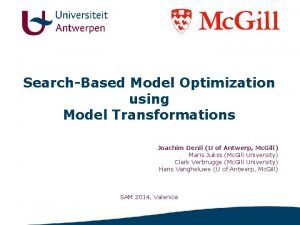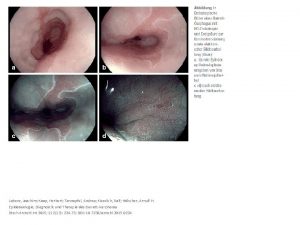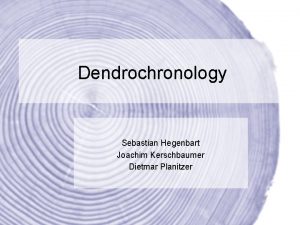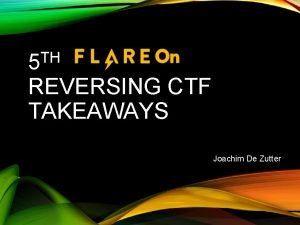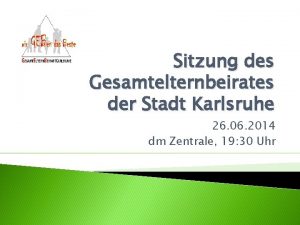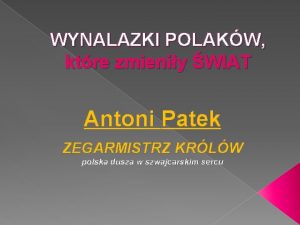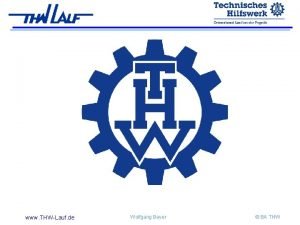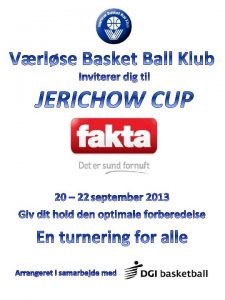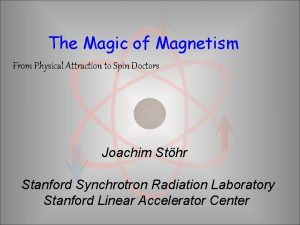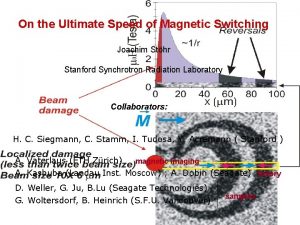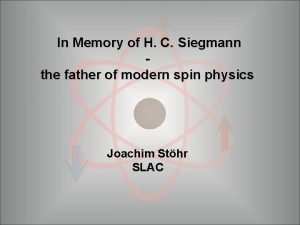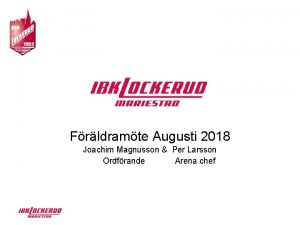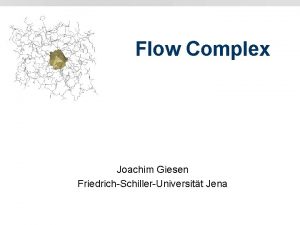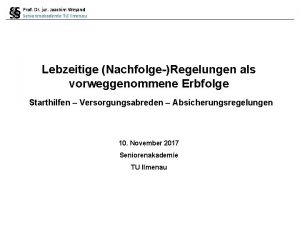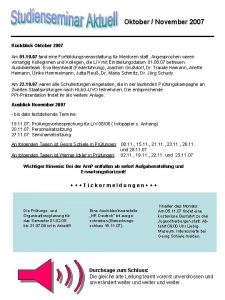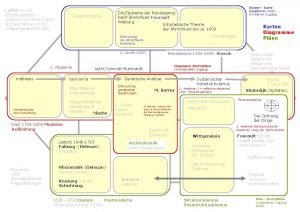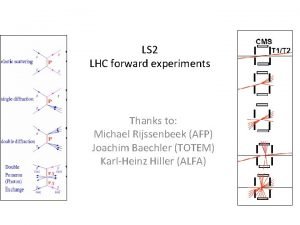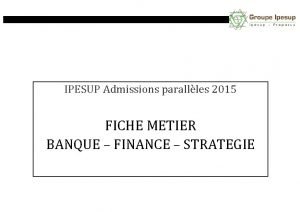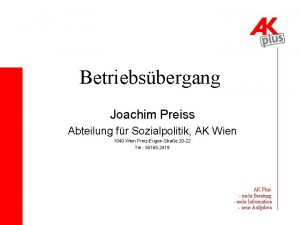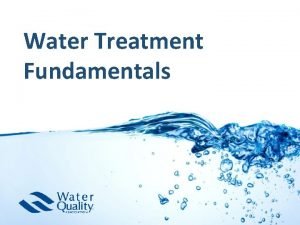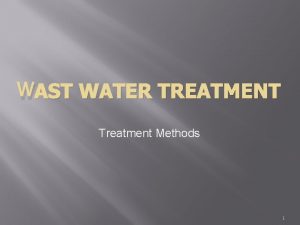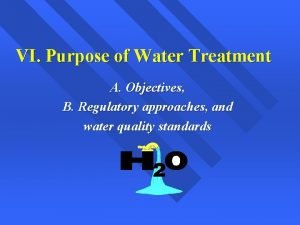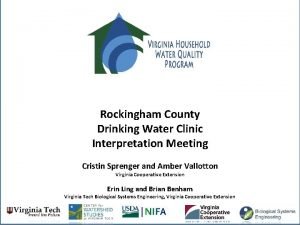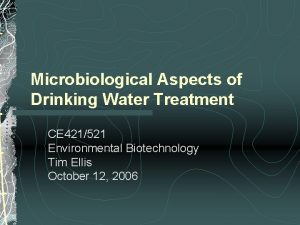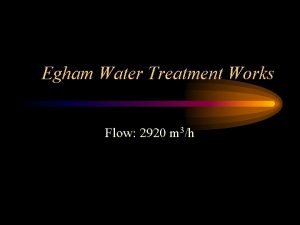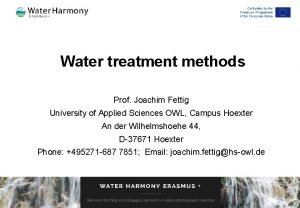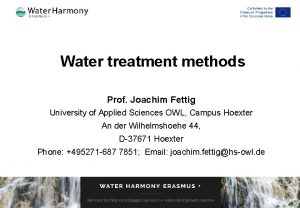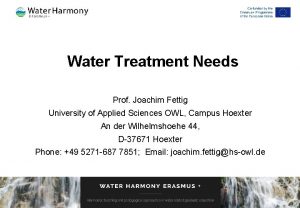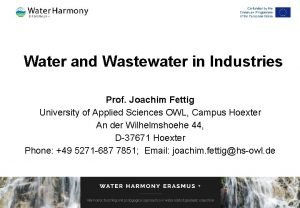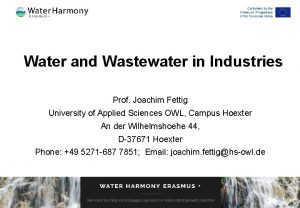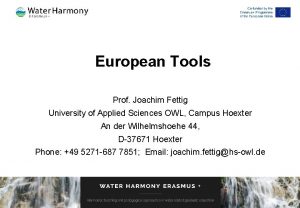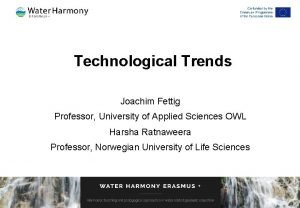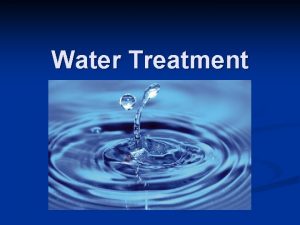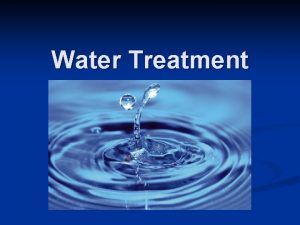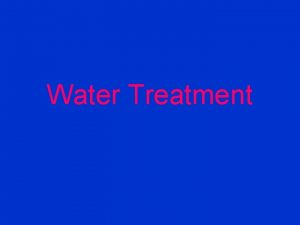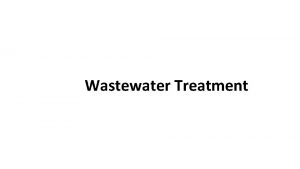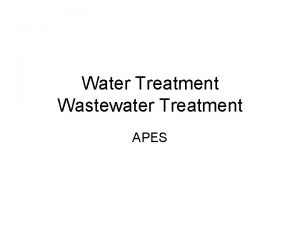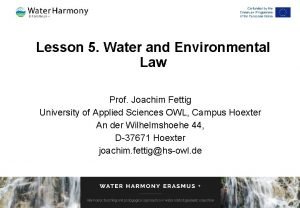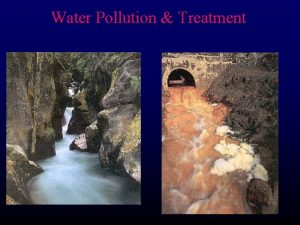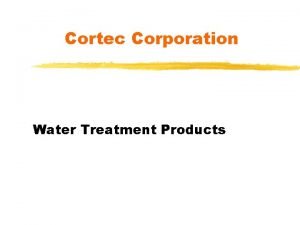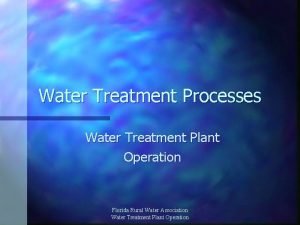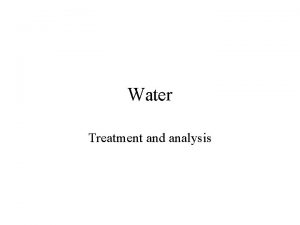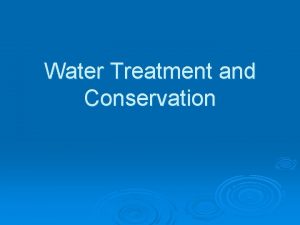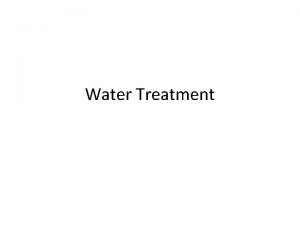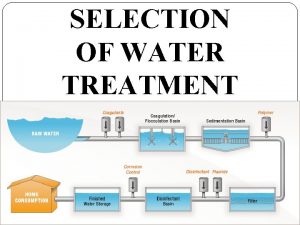Water treatment methods Prof Joachim Fettig University of

































- Slides: 33

Water treatment methods Prof. Joachim Fettig University of Applied Sciences OWL, Campus Hoexter An der Wilhelmshoehe 44, D-37671 Hoexter Phone: +495271 -687 7851; Email: joachim. fettig@hs-owl. de

Learning targets § Understanding of general treatment process § Mastering the principle of the typical solid-liquid separation process § Mastering the principle of physical-chemical treatment method of dissolved in-organic compound § Mastering the principle of biological treatment method of dissolved organic compound Water treatment methods 2

Content - Treatment concepts – general remarks - Overview of treatment processes - Solid-liquid separation - Removal of dissolved inorganic substances - Removal of dissolved organic substances - Final remarks Water treatment methods 3

Treatment concepts – general remarks Development In the past: Treatment in a central mechanical-biological plant onsite or together with domestic wastewater (end-of-pipe) Now: Decentralized (pre-)treatment of separate wastewater streams (point-of-source), followed by a central plant if needed Challenges with separate wastewater streams 1. small volumetric flow rates 2. high concentrations of pollutants 3. often discontinuous flow Water treatment methods 4

Treatment concepts – general remarks Conclusions For pre-treatment purposes, biological processes are suited if § the substances to be removed are degradable, § the process is not affected by other toxic substances, and § adequate adaptability to the fluctuating conditions is possible. Therefore, physical-chemical or chemical processes must often be applied for the (pre-)treatment of separate streams. These processes are also important as process-related measures for emission reduction. Water treatment methods 5

Overview of treatment processes Water treatment methods 6

Solid-liquid separation Sedimentation in inclined-plate settlers Idea: Enlargement of the effective settling area Important aspect: Up-flow operation Typical design parameters: - distance between plates: 20 -100 mm - angle of inclination: 55 - 60° Manufactured sizes: Q = 1 - 300 m 3/h Inclined-plate settler (Courtesy Vereinigte Kesselwerke) Water treatment methods 7

Solid-liquid separation Oil removal by coalescence separators Operating principle: Formation of larger oil drops from fine oil droplets (5 - 20 μm) by hydrodynamic effects General requirements in Germany: Effluent concentrations < 5 mg/L HC when tested with a water/oil mixture according to DIN 1999 Coalescence separator Limitation of mechanical oil separation: Removal of stable emulsified oil droplets Water treatment methods 8

Solid-liquid separation Dissolved air flotation (DAF) Operating principle: - saturation of recycled effluent with pressurized air - formation of air bubbles in the flotation basin - attachment of particles on air bubbles - floating of the air-solid aggregates to the surface Typical design parameters: - hydraulic surface loading: 2 - 15 m 3/(m 2 * h) - operating pressure: 2 - 6 bar - recycle ratio: 0. 1 - 0. 5 (except sludge thickening) - air : solids ratio: 3 - 100 LN / kg TSS Water treatment methods Principle of DAF 9

Solid-liquid separation Flocculation in circular reactors Principle: - dosing of metal coagulants (iron or aluminium salts) into the inflow - floc formation in the central part of the reactor, supported by polymer addition - floc separation by settling in the outer volume of the reactor Operating parameters: Turbo-Circulator (Courtesy Ph. Müller) - hydraulic surface loading: 2 - 6 m 3/(m 2 * h) - coagulant dosages: 5 - 50 mg/L Me - p. H adjustment: p. H = 5. 5 - 7. 5 Water treatment methods 10

Solid-liquid separation Micro- and Ultrafiltration Operating principle: Separation of an inflow (feed) stream into a filtrate (permeate) stream and a concentrate (retentate) stream by organic or inorganic membranes with well-defined pore sizes Differentiation: Microfiltration → separation size 50 - 10, 000 nm operating pressure 0. 5 - 5 bar Principle of membrane filtration Ultrafiltration → separation size 5 - 50 nm operating pressure 1 - 10 bar Water treatment methods 11

Solid-liquid separation Micro- and Ultrafiltration Design selection criteria: - TSS feed concentration - recovery - operating mode - energy demand - residuals and their disposal - fouling potential of the membrane - rinsing and cleaning procedures Operating modes of membrane filtration Operating mode: → cross-flow (applied in wastewater treatment) → dead-end (used for process water treatment) Water treatment methods 12

Solid-liquid separation Typical applications in industries Inclined-plate settlers: Removal of particles and chemical flocs, e. g. after precipitation of heavy metals from metalplating wastewater streams Coalescence separators: Pre-treatment of wastewater containing oil droplets, e. g. effluents from machine shops Dissolved air flotation: Removal of hydrophobic solids with low density, e. g. from wastewater streams generated in food industries and slaughterhouses Compact flocculation: Coagulation of fine particle and colloids, e. g. for producing process water from river water Water treatment methods 13

Solid-liquid separation Typical applications in industries Microfiltration: Removal of fine particles and oil droplets from all kinds of small wastewater streams Ultrafiltration: Separation of emulsions (e. g. drilling oils, compressor condensates) with cross-flow inorganic membranes Separation of proteins from whey, soya extracts etc. Recovery of dyes and sizing agents from dying of textiles Recovery of water-based paints from electrocoating processes Separation of activated sludge flocs from effluents in membrane bio-reactors Water treatment methods 14

Removal of dissolved inorganic substances Ion exchange Operating principle: Uptake of cations or anions from wastewater by porous resin beads that release a stoichiometric amount of ions (of the same charge) originally bound to the resin (sorption stage) Desorption of these ions from the resin by applying a concentrated solution of the ions initially present on the resin (regeneration stage) Operating mode: → co-current (for high ion concentrations) → counter-current (for high effluent qualities) Water treatment methods Source: http: //www. ion-exchange. com. aa 15

Removal of dissolved inorganic substances Precipitation of heavy metals Principle of precipitation processes: Transformation of dissolved substances by chemical reactions in components with low solubility → Hydroxide precipitation: Precipitation of metal ions as hydroxides or basic salts Solubility product L = a(Mez+) * a(OH-)z << 1 → Sulphide precipitation: Precipitation of divalent metal ions as sulfides Precipitation stage Solubility product L = a(Me 2+) * a(S 2 -) << 1 Water treatment methods 16

Removal of dissolved inorganic substances Oxidation Principle of oxidation processes: Release of electrons, increase of the oxidation state Oxidizing agents in industrial wastewater treatment, applied for instance for the detoxification of cyanide: - Hydrogen peroxide H 2 O 2 CN- + H 2 O 2 + H 2 O + H+ NH 4+ + HCO 3 - Ozone O 3 CN- + O 3 + 2 H 2 O + H+ NH 4+ + O 2 + HCO 3 - Sodium hypochlorite Na. OCl 2 CN- + 5 OCl- + H 2 O N 2 + 5 Cl- + 2 HCO 3 Water treatment methods 17

Removal of dissolved inorganic substances Reduction Principle of reduction processes: Uptake of electrons, decrease of the oxidation state Reducing agents in industrial water and wastewater treatment, applied for instance for the detoxification of chromate: - Sodium hydrogen sulfite Na. HSO 3 Na 2 Cr 2 O 7 + 3 Na. HSO 3 + 4 H 2 SO 4 Cr 2(SO 4)3 + 3 Na. HSO 4 + Na 2 SO 4 + 4 H 2 O followed by hydroxide precipitation of Cr(OH)3 - Fe(II) salts, e. g. Fe. SO 4 Na 2 Cr. O 4 + 3 Fe. SO 4 + 4 Na. OH + 4 H 2 O Cr(OH)3 + 3 Fe(OH)3 + 3 Na 2 SO 4 Water treatment methods 18

Removal of dissolved inorganic substances Reverse Osmosis Operating principle: similar to Micro- and Ultrafiltration Characteristic differences: - separation size 1 - 2 nm (dense membranes) - operating pressure 10 - 200 bar - very good removal of ions and large organic molecules - limited rejection of dissolved gases and small uncharged molecules, e. g. silicic acid Source: http: //www. ameriwater. com/products Water treatment methods 19

Removal of dissolved inorganic substances Evaporation Operating principle: Separation of wastewater and both dissolved and suspended substances by applying energy in order to transform the water into vapor Boundary conditions: ® high energy demand (ca. 800 k. Wh/m 3) for single-stage evaporation Source: http: //www. wastewaterevaporators. com ® precipitation of salts, formation of deposits ® pollution of condensate by volatile compounds ® corrosion and foam generation Water treatment methods 20

Removal of dissolved inorganic substances Typical applications in industries Ion exchange: Regeneration of process solutions in metal-plating companies Recovery of noble metals and non-ferrous metals from metal-plating rinsing waters Removal of residual heavy metals from wastewater streams after a precipitation stage Precipitation: Removal of heavy metals in wastewater from metal-plating industries and from flue gas washing processes Removal of fluoride (as Ca. F 2), sulfate (as Ca. SO 4 or as ettringite), phosphate (as Me. PO 4 with iron and aluminium salts, or as hydroxyl apatite with calcium hydroxide), and ammonium (as struvite) in wastewaters of different origin Water treatment methods 21

Removal of dissolved inorganic substances Typical applications in industries Oxidation: Detoxification of cyanide and nitrite in wastewater streams from metal-plating industries Reduction: Detoxification of chromate and nitrite in effluents from metal-plating processes Reverse Osmosis: Concentrating wastewater streams from chemical industries, electroplating, and landfills (in Germany) Recovery of process water in the semiconductor industry and other sectors Evaporation: Water treatment methods Recovery of resources from wastewater streams Pre-treatment prior to combustion, e. g. in pulp production 22

Removal of dissolved organic substances Anaerobic biological treatment Principle: - conversion of organic matter to biogas (CH 4, CO 2) that can be utilized → gain instead of consumption of energy - two-stage process: 1. pre-acidification, 2. methane production - production of surplus sludge quite small Operating parameters: - hydraulic loading: 2 - 30 kg COD / (m 3 * d) - temperature: 30 - 40°C (mesophilic conditions, preferred operating mode) Water treatment methods Scheme of an UASB-reactor (Lettinga und Hulshoff Pol, 1991) 23

Removal of dissolved organic substances Aerobic biological treatment Principle: - conversion of organic matter to CO 2, H 2 O and biomass; yield up to 50 % - removal of nitrogen (nitrification/denitrification) a Process realisation: - (multi-stage) activated sludge systems - biofilm reactors Operating parameters: - sludge loading: < 0. 1 - 0. 5 kg BOD / (kg MLSS * d) - hydraulic retention time: 6 - > 24 h Water treatment methods Flow diagram of the activated sludge process 24

Removal of dissolved organic substances Application of biological processes in industries Anaerobic treatment: Pre-treatment of wastewater with high concentrations of biodegradable organic matter (COD = 1. 5 - 40 g/L), e. g. wastewater from food industries, breweries and pulp and paper production Aerobic treatment: Water treatment methods Removal of biodegradable organic matter from wastewater generated by all kind of industries, in particular by food companies, petrochemical plants, chemical industries, tanneries, textile companies, and paper mills Post-treatment of anaerobically treated wastewater in order to remove residual BOD and nutrients (nitrogen, phosphorous) 25

Removal of dissolved organic substances Adsorption Principle: Accumulation of organic substances at the inner surface of a porous solid (adsorbent), most often activated carbon Process configurations: - application of powdered material in a threestep batch process that includes a) dosing, b) reaction and c) separation of the adsorbent - use of granular adsorbent as a filter material in a continuously operated adsorption column Source: http: //generalcarbon. com Water treatment methods 26

Removal of dissolved organic substances Oxidation at low temperatures. . . with hydrogen peroxide H 2 O 2: Activation by UV-irradiation or addition of Fe(II)-salts (Fenton’s reagent) in order to generate OH radicals H 2 O 2 + Fe 2+ OH + OH- + Fe 3+ If iron salts are used, they will precipitate as hydroxides, i. e. management of residuals will be required. . with ozone O 3: Combination with UV-irradiation for an increased generation of hydroxyl radicals is advantageous h * O 3 + H 2 O Water treatment methods 2 OH + O 2 27

Removal of dissolved organic substances Oxidation at high temperatures Operating principle of “wet oxidation”: Conversion and partial mineralization of refractory organic substances with air or oxygen Process schemes: → low-pressure oxidation (p = 6 - 10 bar, T = 140 - 180 °C) → high-pressure process (p = 20 - 200 bar, T = 250 - 330 °C) → oxidation in super-critical water (still under development) Water treatment methods Scheme of the wet oxidation process 28

Removal of dissolved organic substances Combustion Principle: Evaporation of water and oxidation of organic substances in a gas burner Pre-condition: High concentration of organic material (> 10 % by mass, or COD > 100 g/L) Estimate of the net calorific value: Gas burner for wastewater combustion (System BASF) HU [k. J/kg] = 13 * COD [g/kg]) Operational challenge: Handling of slag from salts in the wastewater Water treatment methods 29

Removal of dissolved organic substances Application of physico-chemical processes in industries Adsorption: Removal of specific components or total COD, e. g. in chemical or metal-processing industries Low-temperature oxidation: Pre-treatment of wastewater with refractory matter (COD concentrations of 0. 5 - 5 g/L) Removal of chelating agents in wastewater from metal-plating industries High-temperature oxidation: Pre-treatment of chemical wastewater with refractory matter (COD content of 5 - 100 g/L) Combustion: Water treatment methods Disposal of wastewater with very high organic content, e. g. in chemical industries and refineries 30

Final remarks 1. There are many technologies available to separate or eliminate pollutants from industrial wastewater streams. 2. In Europe, the “Best Available Techniques Reference Documents” (BREFs) define the state-of-the-art, also for water use, in about 30 industries. 3. Together with national laws they ensure that industrial wastewater is usually treated very efficiently. 4. Industrial wastewater treatment can be based on a central biological plant, but it often requires the application of physicalchemical or chemical processes for the (pre-)treatment of separate streams. Water treatment methods 31

Final remarks 5. These processes must be selected and designed by taking all of the specific boundary conditions into account. 6. Therefore standard solutions are not the best option but individual process configurations have to be developed in order to obtain optimal removal efficiencies at reasonable costs. Future tasks for water management in industries: § Further reduction of water demand in processes and closing of water cycles where possible (clean technology) § Refinement of separation techniques for refractory organic pollutants that could have a long-term effect on the environment Water treatment methods 32

Questions § Why the inclined-plate has higher removal efficiency? § Why should the inclination angle be limited to 55 -60 degree for the inclined-plate ? § What is the common oxidant and reductant used in industrial wastewater treatment? § Describe the principle of three softening technologies. § Describe the Pros and cons of the anaerobic biological treatment technology. Water treatment methods 33
 Water and water and water water
Water and water and water water Joachim denil
Joachim denil Jesus bloodline
Jesus bloodline Joachim koop
Joachim koop Joachim kerschbaumer
Joachim kerschbaumer College joachim du bellay authon du perche
College joachim du bellay authon du perche Confuser ex
Confuser ex Joachim bovin
Joachim bovin Joachim frisch karlsruhe
Joachim frisch karlsruhe Antoni patek anna piasecka
Antoni patek anna piasecka Joachim süß
Joachim süß Joachim jerichow
Joachim jerichow Joachim dejaco
Joachim dejaco Joachim stöhr
Joachim stöhr Joachim stöhr
Joachim stöhr Joachim stöhr
Joachim stöhr Joachim magnusson mariestad
Joachim magnusson mariestad Joachim haeberlen
Joachim haeberlen Joachim giesen
Joachim giesen Joachim weyand
Joachim weyand Joachim grußdorf
Joachim grußdorf Joachim da fiore
Joachim da fiore Joachim baechler
Joachim baechler Joachim savigny
Joachim savigny Johann joachim winckelmann
Johann joachim winckelmann Joachim krebser
Joachim krebser Joachim preiss
Joachim preiss Indirect wax pattern
Indirect wax pattern Water treatment fundamentals
Water treatment fundamentals Wast water treatment
Wast water treatment Objectives of water treatment
Objectives of water treatment Water treatment rockingham county
Water treatment rockingham county Ground water treatment process
Ground water treatment process Egham water treatment works
Egham water treatment works

